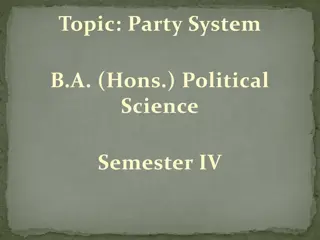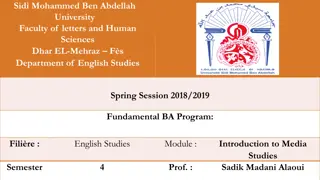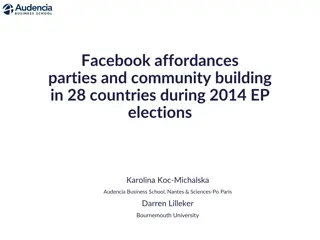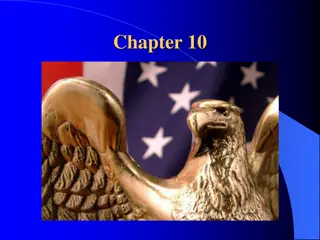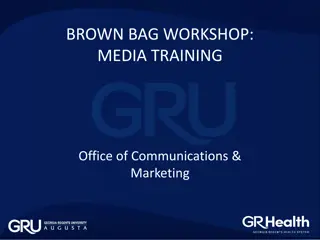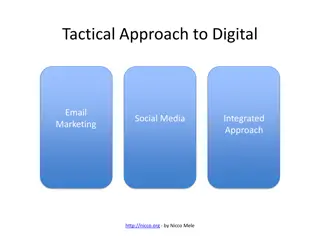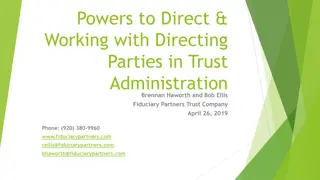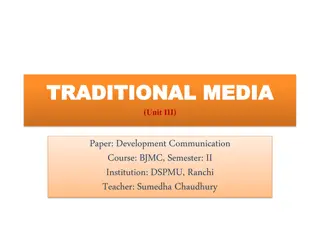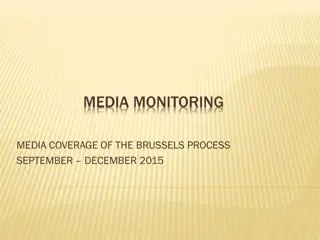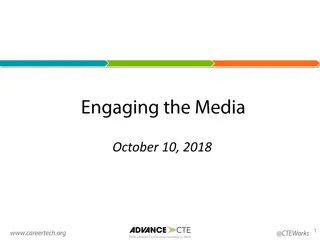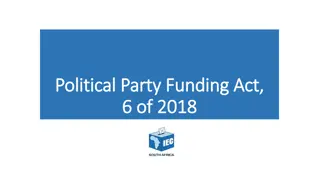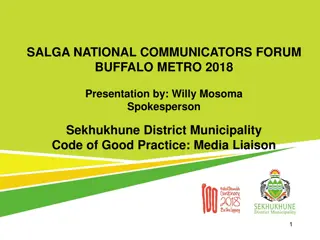
Political Parties: Plurality vs. Proportionality, Duverger's Law, and More
Delve into the world of political parties and electoral systems, exploring concepts such as plurality versus proportionality, Duverger's Law, and the impact of different voting systems on party representation. Learn how Single Member District Plurality (SMDP) elections foster a two-party system, while Proportional Representation (PR) elections encourage the existence of multiple parties. Gain insights into the dynamics of like-minded people banding together to influence government control and the potential for ending the dominance of the two-party system.
Download Presentation

Please find below an Image/Link to download the presentation.
The content on the website is provided AS IS for your information and personal use only. It may not be sold, licensed, or shared on other websites without obtaining consent from the author. If you encounter any issues during the download, it is possible that the publisher has removed the file from their server.
You are allowed to download the files provided on this website for personal or commercial use, subject to the condition that they are used lawfully. All files are the property of their respective owners.
The content on the website is provided AS IS for your information and personal use only. It may not be sold, licensed, or shared on other websites without obtaining consent from the author.
E N D
Presentation Transcript
Welcome! Christopher M. Celaya ccelaya@fas.harvard.edu Office Hours in CGIS Cafe: -Fridays 11-12, 1-2, 5-6
Administration Midterms
Administration Midterms Paper Assignment Specifics Coming Soon
Political Parties Political Party
Political Parties Political Party Like-minded people who band together to take control of the government
Political Parties Political Party Like-minded people who band together to take control of the government Plurality versus Proportionality
Political Parties Political Party Like-minded people who band together to take control of the government Plurality versus Proportionality One winner versus multiple winners
Video Political Party Like-minded people who band together to take control of the government Plurality versus Proportionality One winner versus multiple winners Ending the Two Party System
Political Parties Political Party Like-minded people who band together to take control of the government Plurality versus Proportionality One winner versus multiple winners Duverger s Law
Political Parties Political Party Like-minded people who band together to take control of the government Plurality versus Proportionality One winner versus multiple winners Duverger s Law Single Member District Plurality (SMDP) elections lead to two parties Proportional Representation (PR) elections lead to multiple parties
Political Parties Political Party Like-minded people who band together to take control of the government Plurality versus Proportionality One winner versus multiple winners Duverger s Law Single Member District Plurality (SMDP) elections lead to two parties Proportional Representation (PR) elections lead to multiple parties Party Machine
Political Parties Political Party Like-minded people who band together to take control of the government Plurality versus Proportionality One winner versus multiple winners Duverger s Law Single Member District Plurality (SMDP) elections lead to two parties Proportional Representation (PR) elections lead to multiple parties Party Machine Run by a boss or small group which controls parties and candidates
Political Parties Political Party Like-minded people who band together to take control of the government Plurality versus Proportionality One winner versus multiple winners Duverger s Law Single Member District Plurality (SMDP) elections lead to two parties Proportional Representation (PR) elections lead to multiple parties Party Machine Run by a boss or small group which controls parties and candidates Primary Elections
Political Parties Political Party Like-minded people who band together to take control of the government Plurality versus Proportionality One winner versus multiple winners Duverger s Law Single Member District Plurality (SMDP) elections lead to two parties Proportional Representation (PR) elections lead to multiple parties Party Machine Run by a boss or small group which controls parties and candidates Primary Elections Election to determine who will represent a party: Negatively affected political machine
Political Parties Political Party Like-minded people who band together to take control of the government Plurality versus Proportionality One winner versus multiple winners Duverger s Law Single Member District Plurality (SMDP) elections lead to two parties Proportional Representation (PR) elections lead to multiple parties Party Machine Run by a boss or small group which controls parties and candidates Primary Elections Election to determine who will represent a party: Negatively affected political machine Split-ticket Voting
Political Parties Political Party Like-minded people who band together to take control of the government Plurality versus Proportionality One winner versus multiple winners Duverger s Law Single Member District Plurality (SMDP) elections lead to two parties Proportional Representation (PR) elections lead to multiple parties Party Machine Run by a boss or small group which controls parties and candidates Primary Elections Election to determine who will represent a party: Negatively affected political machine Split-ticket Voting Splitting vote between parties, for example, voting for Rep. in Congress and Dem. for President
Political Parties Political Party Like-minded people who band together to take control of the government Plurality versus Proportionality One winner versus multiple winners Duverger s Law Single Member District Plurality (SMDP) elections lead to two parties Proportional Representation (PR) elections lead to multiple parties Party Machine Run by a boss or small group which controls parties and candidates Primary Elections Election to determine who will represent a party: Negatively affected political machine Split-ticket Voting Splitting vote between parties, for example, voting for Rep. in Congress and Dem. for President Realignment/Critical Elections
Political Parties Political Party Like-minded people who band together to take control of the government Plurality versus Proportionality One winner versus multiple winners Duverger s Law Single Member District Plurality (SMDP) elections lead to two parties Proportional Representation (PR) elections lead to multiple parties Party Machine Run by a boss or small group which controls parties and candidates Primary Elections Election to determine who will represent a party: Negatively affected political machine Split-ticket Voting Splitting vote between parties, for example, voting for Rep. in Congress and Dem. for President Realignment/Critical Elections Creating a new party order
Political Parties Political Party Like-minded people who band together to take control of the government Plurality versus Proportionality One winner versus multiple winners Duverger s Law Single Member District Plurality (SMDP) elections lead to two parties Proportional Representation (PR) elections lead to multiple parties Party Machine Run by a boss or small group which controls parties and candidates Primary Elections Election to determine who will represent a party: Negatively affected political machine Split-ticket Voting Splitting vote between parties, for example, voting for Rep. in Congress and Dem. for President Realignment/Critical Elections Creating a new party order Realignments?
Political Parties: Additional Terms District Magnitude How many legislators are elected in a district
Political Parties: Additional Terms District Magnitude How many legislators are elected in a district Regional Coalitions One way to escape Duverger s Law
Political Parties: Additional Terms District Magnitude How many legislators are elected in a district Regional Coalitions One way to escape Duverger s Law Small Party Veto Sometimes a small third party has immense power when coalition building
Political Parties Discussion Questions 1) How important is it that third parties receive representation in the Federal Government? Consider our federal system. 2) Proportional representation is a way to get more groups represented in government. How important is this? 3) The readings listed a large group of pros and cons for high party strength in the government (e.g. Parties can be held accountable to the people, but they can also hide issues such as slavery). Discuss those considerations and come to a conclusion whether strong parties or weak parties are better? 4) Discuss the pros and cons of party realignments. 5) One criticism of strong party identification in government is that politicians are more likely to vote their party line, which leads to gridlock. At the same time, this does mean that they are representing the interests of the party well. Is this a worthwhile trade-off, or should politicians vote however they feel is best?
Media Background News that Matters:
Media Background News that Matters: Priming?
Media Background News that Matters: Priming: Places something at the top of your head when you consider an issue/candidate (relational) Affects assessments of performance (not character), on unsophisticated: Iyengar and Kinder
Media Background News that Matters: Priming: Places something at the top of your head when you consider an issue/candidate (relational) Affects assessments of performance (not character), on unsophisticated: Iyengar & Kinder 1987 Framing?
Media Background News that Matters: Priming: Places something at the top of your head when you consider an issue/candidate (relational) Affects assessments of performance (not character), on unsophisticated: Iyengar & Kinder 1987 Framing: Controlling the context in which an issue is considered KKK; Free speech or civil disturbance?: Nelson et al 1997 Equivalency (Unreliable): Druckman 2001 Emphasis (Sometimes): Druckman 2001
Media Background News that Matters: Priming: Places something at the top of your head when you consider an issue/candidate (relational) Affects assessments of performance (not character), on unsophisticated: Iyengar & Kinder 1987 Framing: Controlling the context in which an issue is considered KKK; Free speech or civil disturbance?: Nelson et al 1997 Equivalency (Unreliable): Druckman 2001 Emphasis (Sometimes): Druckman 2001 Agenda Setting?
Media Background News that Matters: Priming: Places something at the top of your head when you consider an issue/candidate (relational) Affects assessments of performance (not character), on unsophisticated: Iyengar & Kinder 1987 Framing: Controlling the context in which an issue is considered KKK; Free speech or civil disturbance?: Nelson et al 1997 Equivalency (Unreliable): Druckman 2001 Emphasis (Sometimes): Druckman 2001 Agenda Setting: Determining what issues consumers of media are exposed to Happens for many issues, most important for issues that affect people; Iyengar & Kinder, 1987
Media Key Terms Agenda Setting
Media Key Terms Agenda Setting Priming
Media Key Terms Agenda Setting Priming Framing
Media Key Terms Agenda Setting Priming Framing Neutralization
Media Key Terms Agenda Setting Priming Framing Neutralization Indifference
Media Key Terms Agenda Setting Priming Framing Neutralization Indifference Sound Bite
Media Key Terms Agenda Setting Priming Framing Neutralization Indifference Sound Bite New Media
Media Key Terms Agenda Setting Priming Framing Neutralization Indifference Sound Bite New Media Equal Time Rule/Fairness Doctrine
Media Key Terms Agenda Setting Priming Framing Neutralization Indifference Sound Bite New Media Equal Time Rule/Fairness Doctrine Yellow Journalism
Media Key Terms Agenda Setting Priming Framing Neutralization Indifference Sound Bite New Media Equal Time Rule/Fairness Doctrine Yellow Journalism Narrowcasting
Discussion Questions 1) Since most media organizations are private institutions, is it fair that they have to adhere to concepts like the Fairness Doctrine and the Equal Time Rule? Even if it harms their profits? 2) The New Media has greatly increased both the amount of news and access to news. But though these messages are broadly cast, each source has become narrower. Is this a worthwhile tradeoff? 3) Which (if any) is the largest threat to accurate citizen access to political issues; Agenda Setting, Priming or Framing? Why? 4) Discuss how the fact that the media is market-driven might affect the ways in which Agenda Setting, Framing and Priming might take place? How might that enhance or limit politicians ability to use the media in this way?



